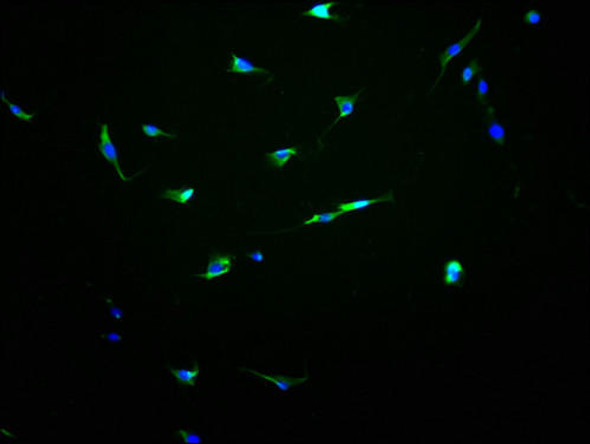Description
| Antibody Name: | SNCAIP Antibody |
| Antibody SKU: | PACO01566 |
| Size: | 50ug |
| Host Species: | Rabbit |
| Tested Applications: | ELISA, WB, IHC |
| Recommended Dilutions: | WB:1:500-1:2000, IHC:1:100-1:300 |
| Species Reactivity: | Human, Mouse |
| Immunogen: | synthesized peptide derived from the C-terminal region of human Synphilin-1. |
| Form: | Liquid |
| Storage Buffer: | Liquid in PBS containing 50% glycerol, 0.5% BSA and 0.02% sodium azide. |
| Purification Method: | The antibody was affinity-purified from rabbit antiserum by affinity-chromatography using epitope-specific immunogen. |
| Clonality: | Polyclonal |
| Isotype: | IgG |
| Conjugate: | Non-conjugated |
| Synonyms: | SNCAIP; Synphilin-1; Sph1; Alpha-synuclein-interacting protein |
| UniProt Protein Function: | SNCAIP: Isoform 2 inhibits the ubiquitin ligase activity of SIAH1 and inhibits proteasomal degradation of target proteins. Isoform 2 inhibits autoubiquitination and proteasomal degradation of SIAH1, and thereby increases cellular levels of SIAH. Isoform 2 modulates SNCA monoubiquitination by SIAH1. Defects in SNCAIP may be a cause of Parkinson disease (PARK). A complex neurodegenerative disorder characterized by bradykinesia, resting tremor, muscular rigidity and postural instability. Additional features are characteristic postural abnormalities, dysautonomia, dystonic cramps, and dementia. The pathology of Parkinson disease involves the loss of dopaminergic neurons in the substantia nigra and the presence of Lewy bodies (intraneuronal accumulations of aggregated proteins), in surviving neurons in various areas of the brain. The disease is progressive and usually manifests after the age of 50 years, although early-onset cases (before 50 years) are known. The majority of the cases are sporadic suggesting a multifactorial etiology based on environmental and genetic factors. However, some patients present with a positive family history for the disease. Familial forms of the disease usually begin at earlier ages and are associated with atypical clinical features. 6 isoforms of the human protein are produced by alternative splicing.Protein type: VesicleChromosomal Location of Human Ortholog: 5q23.2Cellular Component: presynaptic membrane; synaptic vesicle; cell soma; cytoplasmMolecular Function: identical protein binding; protein binding; ubiquitin protein ligase bindingBiological Process: regulation of neurotransmitter secretion; dopamine metabolic processDisease: Parkinson Disease, Late-onset |
| UniProt Protein Details: | |
| NCBI Summary: | This gene encodes a protein containing several protein-protein interaction domains, including ankyrin-like repeats, a coiled-coil domain, and an ATP/GTP-binding motif. The encoded protein interacts with alpha-synuclein in neuronal tissue and may play a role in the formation of cytoplasmic inclusions and neurodegeneration. A mutation in this gene has been associated with Parkinson's disease. Alternative splicing results in multiple transcript variants. [provided by RefSeq, Apr 2015] |
| UniProt Code: | Q9Y6H5 |
| NCBI GenInfo Identifier: | 76563940 |
| NCBI Gene ID: | 9627 |
| NCBI Accession: | NP_005451 |
| UniProt Secondary Accession: | Q9Y6H5,Q05BS1, Q1PSC2, Q49AC6, Q504U9, Q6L984, Q6L985 Q6L986, Q9HC59, D3DSZ1 |
| UniProt Related Accession: | Q9Y6H5 |
| Molecular Weight: | 64,469 Da |
| NCBI Full Name: | synphilin-1 isoform 1 |
| NCBI Synonym Full Names: | synuclein alpha interacting protein |
| NCBI Official Symbol: | SNCAIP |
| NCBI Official Synonym Symbols: | Sph1; SYPH1 |
| NCBI Protein Information: | synphilin-1 |
| UniProt Protein Name: | Synphilin-1 |
| UniProt Synonym Protein Names: | Alpha-synuclein-interacting protein |
| Protein Family: | Synphilin |
| UniProt Gene Name: | SNCAIP |
| UniProt Entry Name: | SNCAP_HUMAN |






